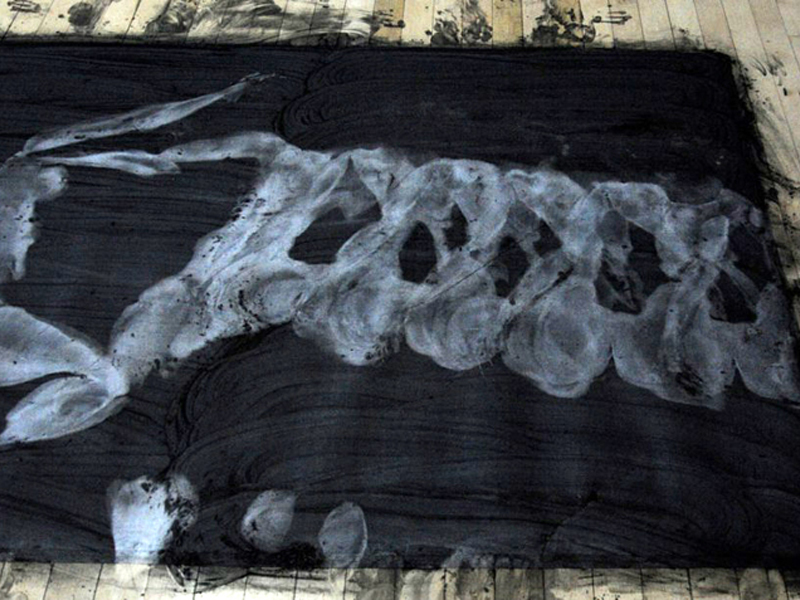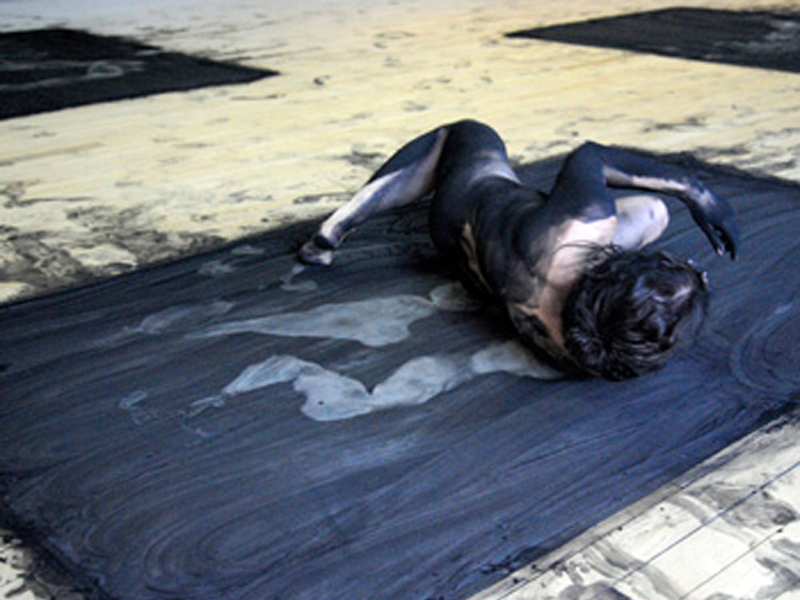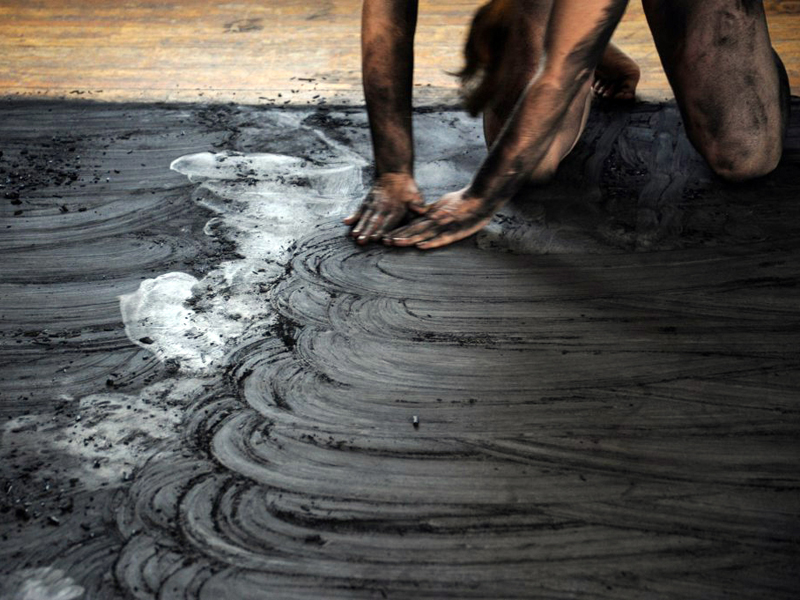published 6 January 2017
what remains and is to come is a performance installation created and performed in collaboration with fellow choreographer Katrina Brown. In the performance we work with paper, charcoal, body and breath. The work is performed in gallery type spaces. Human-scale charcoal imprints and a sonic soundscape – by Tim Sayer – remain after the performance ends. The imprints have been considered as anamorphic images and discussed alongside Etienne Jules Marey’s Chronophotographiques and Marcel Duchamp’s Nude Descending a Staircase by writer and artist Mark Leahy. They have been compared to HoIbein’s anamorphic painting of a skull by dance artist, scholar and lecturer Nigel Stewart. (See info/links at bottom of article). The charcoal covered bodies that emerge in the course of the performance invariably evoke memories of Yves Klein’s models in his Anthropometry paintings. We acknowledge these histories of visual arts – acknowledge that the work can be read and understood in relations with these histories. The work can also be understood through the processes that informed its making – and that are activated in its being performed. In this article I give an account of those processes, how they grew out of our sensibilities as choreographers working collaboratively with each other – and working collaboratively with materials: with paper, charcoal, body, breath.

Beginning with relation
We bring our interests and materials; we do not bring a particular theme. We agree to dialogue, to work together and to make something without knowing in advance what that something might be. Making large-scale imprints is simply not in the picture! We’re interested in fostering conditions in which doing or making something ‘interesting’ is replaced by a concern towards the relational event – the ‘what-is-happening’ in the working and making together. The orientation of attention is towards the situation itself: the two of us working with the materials of our choreographic practices: paper, charcoal, and the material more often associated with choreography – the body.
An initial approach was to set up situations in which one worked with the materials while the other watched, interspersing this activity with periods of talking. The task of the doer was to engage with the materials, to work with what was in the situation rather than to bring an idea to the situation. The task of the watcher was to attend to what was happening in the event of the working. The word ‘attend’ indicates the need for the watcher’s presence in experiencing what is happening, which is qualitatively different from her developing an opinion about what is happening.
What came through this method was a close attention to our own tendencies, habits and desires – noticing how materials can be treated as tools for those desires. This can be very subtle including how hand eye co-ordination operates to guide the movement of the hand that holds the charcoal – and in so doing aims for particular outcome. We gave up holding charcoal in the hand. The decision to not use hand eye co-ordination and to not hold the charcoal in the hand opened a different kind of relationship with charcoal. Charcoal was disengaged from its role as tool for a human intent of performing the ‘job’ of drawing. This was the initial shift towards a commitment to making in relations-with materials, one that brought forward a fuller engagement with materials, with their properties and with their capacities.

Just noticing and agency
This shift nuanced the quality of attention in a fuller sense of non-separation from the event. Towards an attitude of impartiality. A practice of non-interfering. A practice of just noticing.
From here an awareness of micro events that the materials ‘performed’ became present. Some examples: a charcoal stick releases sound as it breaks; charcoal splinters and spreads under physical pressure; paper absorbs increasing amounts of charcoal as the charcoal breaks up; skin contact removes charcoal from paper; charcoal clings to skin and clothing. Through firstly giving an account of what was noticed, such as the micro events just described, and then entering into a more reflective and discursive mode of conversation, a particular understanding emerged: material being acted on by another material causes change: it causes something to happen. Agency is enacted by both human and non-human materials.
Continuing to work with this quality of attending, with just noticing, a further insight came forward. This was that change occurs in the event of what happens between materials: it happens in relation. Moreover, change occurs not through a distinct material acting on another material, not through a subject acting on an object in an inter-relational exchange. When change happens materials are each/all agential in that change. The body’s capacity to jump causes pressure to break the charcoal – while the charcoal’s capacity to crumble causes it to cling to skin, and to paper – while paper’s capacity to absorb causes the charcoal to meld with the paper. (For a bit more on material agency and relations see note on Karen Barad below.)

Continuing
Still continuing with ‘just noticing’ we began to identify incremental stages of increasing relations between paper, charcoal, body and breath. On paper this led from white paper to charcoal covered blackened paper.
With the paper completely blackened there is a sort-of completion in the relational event, in the transformation from white to black paper, from pieces of charcoal to crumbs. In this moment of apparent completion, material relational capacities inhere. These include the capacity of charcoal to cling to body, for skin to absorb charcoal, for paper to record the bodily movement on charcoal. These capacities, activated in the intra-relational event of a body in contact with charcoal covered paper, produce capture: a bodily imprint. (With this, issues of representation are implicated. For an account of how the issue of representation is addressed in the making of the work see link to ‘Processual constructions’ at end of this article). We continue with incrementally increasing relations. From still body in contact with charcoal covered paper – to moving body – to greater – and greater – degrees of movement.
The choreography of the performance
An incremental and ongoing accumulating of stages of relation is enacted in the performance installation ‘what remains and is to come’.
Every movement is ‘in service’ to accumulating relations.
Each performance is configured differently, responding to the particular site.
The audience is invited ‘into’ the event. They occupy the space of the performance and can move within the space as they chose.
The sound of breath and of materials working together at times envelope the space.
Sounds and charcoal imprints remain after performers leave.
Links and notes
Intro
Video on Holbein’s anamorphic skull
Étienne-Jules Marey’s chronophotographiques 1890-1904
Duchamp’s Nude Descending a Staircase
Mark Leahy’s text ‘anamorphic trace: sensing doubleness in image and event‘ appears in the artist book ‘what remains and is to come: a document’
A further piece of writing by Mark, written when he joined in the early part of the research, can be found on his website
Nigel Stewart is senior lecturer in Dance and Theatre in the Lancaster Institute for the Contemporary Arts (LICA) at Lancaster University. One group of Fine Art and Theatre students in LICA are using what remains and is to come as a key reference point for their own practical project in Nigel’s third-year module Contemporary Dance and the Visual Arts.
TateShots: Yves Klein – Anthropometries
Just noticing and agency
Barad, K. (2007) Meeting the Universe Halfway: Quantum Physics and the Entanglement of Matter and Meaning, Durham NC: Duke University Press.
In this book science philosopher and feminist theorist Karen Barad proposes an understanding of agential capacities that inheres not in things but in relations: a world coming into being not through the interaction of pre-existing boundaried objects – but through the inseparability of agentially intra-acting phenomena (Barad, 2007:139).
Continuing
My account of how the issue of representation is addressed in the making of ‘what remains and is to come’ is given in chapter four of ‘Processual constructions: towards a non-representational poetics of choreography’. This chapter also reflects on Karen Barad’s interest in material agency and relations.


